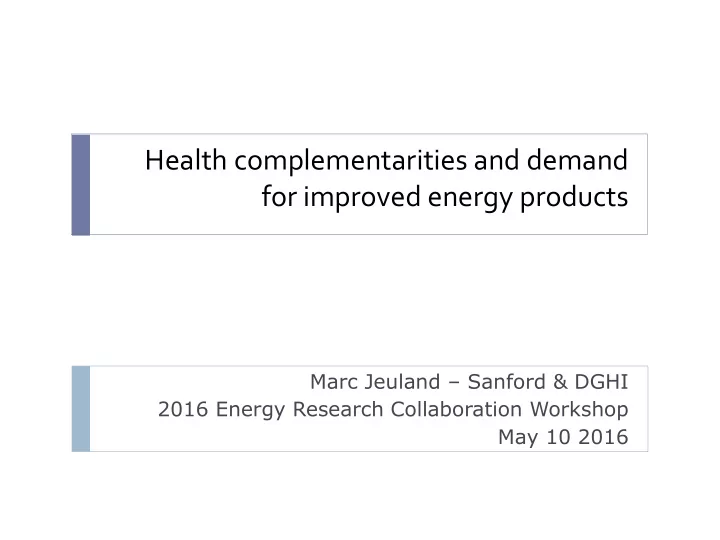

Health complementarities and demand for improved energy products Marc Jeuland – Sanford & DGHI 2016 Energy Research Collaboration Workshop May 10 2016
General motivation (I): Environmental burden of disease Several ‘preventable’ diseases continue to contribute significantly to the global burden of disease
General motivation (II): Environmental burden of disease Fraction of DALYs attributable to the environment, by country (WHO, 2016) Fraction of DALYs attributable to the environment (WHO, 2016) 3
General motivation (II): Environmental burden of disease Household air pollution from use of dirty fuels and stoves: Now the leading environmental risk factor for global disease Fraction of DALYs attributable to the environment (WHO, 2016) Comparative risk assessment: 33% of respiratory illness is related to HAP (WHO, 2016), 17% of lung cancer, 18% of IHD, 26% of stroke, & 24% of 4 COPD
General motivation (II): Environmental burden of disease Lack of access to safe water and sanitation : Consistently among top 2-3 environmental risk factors for global disease Fraction of DALYs attributable to the environment (WHO, 2016) Comparative risk assessment: 34% of diarrheal diseases are related to drinking water (WHO, 2016) Also a variety of other conditions (parasitic, 5 bacterial, vector-related)
General motivation: Environmental burden of disease Several ‘preventable’ diseases continue to contribute significantly to the global burden of disease The donor / policy community thinks of these as separate problems, for good reason: Makes problems manageable Different agencies / community actors are involved (or invested) in each Resources are limited, and multiple interventions are expensive, and complicated to manage (well) It is hard to make comparisons of incommensurable outcomes
3 potential problems with this separation 1. Complementarities across interventions Higher water quality reduces diarrhea, which improves overall health and resistance to acute respiratory illness (ARI) 2. Substitution across interventions Investing in water quality depletes resources that would have been used for preventing ARI 3. Under-investment due to multiple risks Susceptible population may see little value in reducing one risk if other risks remain high Research question: Which of these explanations is most relevant to observed behavior?
My current/recent work on these issues 1. Systematic reviews of studies on adoption of clean stoves & fuels 2. Effect of higher quality sources of (Lewis & Pattanayak 2012) water on water treatment (Jeuland et → Reveal correlations with other al. 2016) risk-reducing behaviors → Negative compensating behavior 3. Sanitation promotion followed by improved stove auctions (Work w/PhD student Jenny Orgill, in progress) 4. Demand for reduced risk of diarrheal and respiratory disease (Work w/Pattanayak and others, in progress) → Stated preferences suggest tight budget constraints; and complex interactions
Stay with us! http://www.dukeenergyhealth.org/ 9
Recommend
More recommend